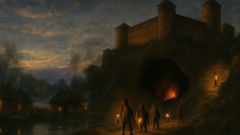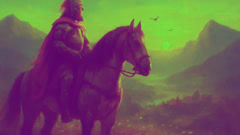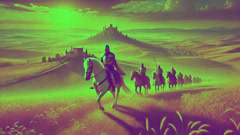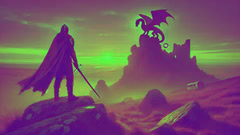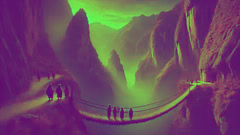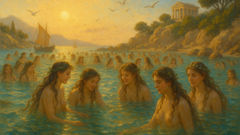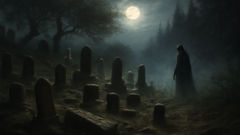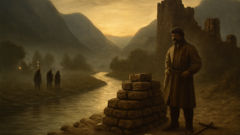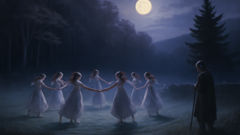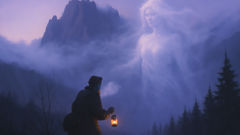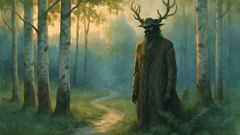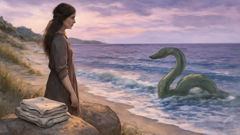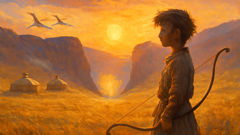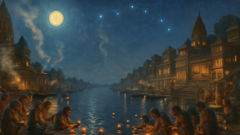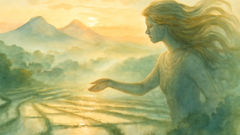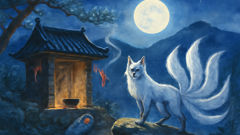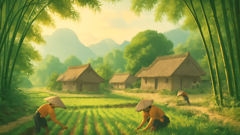Introduction
At the bend of the Vistula where the river slows and the stone terraces of Wawel rise like an old, weathered spine, Krakow held its breath. The city had always been a place of layered voices—merchants calling their wares, bell towers tolling, children weaving between cart wheels—but for a time a darker rhythm set the pace. A dragon lived beneath Wawel Hill, and its shadow fell across the market stalls and the rafters of the cathedral. It came at night from the cave, a rumble of scales and hot breath that singed the wooden shutters of houses near the riverside. Farmers drove their cattle inland, shepherds kept their flocks close, and even the bravest knights who rode to challenge the beast returned with scorched armor and hollow eyes. Yet among Krakow’s many citizens a different kind of courage took shape. In a narrow lane a cobbler named Jakub—hands callused by leather, eyes quick as a cat’s, and heart tuned to the rhythms of small miracles—watched the city’s fear and prepared to answer it in a way none of the heralded men-at-arms ever imagined. Jakub had neither sword nor steed; he had only craft, curiosity, and a stubbornness that makes for legends. This is the story of how the Wawel Dragon met a plan born in a shoemaker’s shop, and how Krakow learned, anew, that cleverness and care are a kind of power.
When Krakow Froze: Scales Over the Market
The dragon arrived in stages, as great creatures do in stories and dreams. At first there were missing goats and an odd stench drifting from the riverside, something acrid and sulfurous that clung to washing and hair. People said a beast had come; the mayor sent for knights, and speeches were made beneath the arched entrance to the market. The knights were splendid in their plated mail, banners snapping in the wind, and many believed armor could temper fate. But when the first knight rode toward Wawel’s mouth and the dragon opened its cavern in a rasping exhale of smoke and ember, the horse bolted and the knight’s lance bent like reed. Tales spread of men who tried and failed: a pair of brothers who were singed to silence, a captain who returned halfway through the valley soot-black and speechless, and a young squire whose courage ended in a scorched cloak. The city’s confidence broke in small ways at first—shops shuttered a day earlier, bread left under cloth to cool in dark cellars—but fear widened into something communal, a hush between bell rings, a tenderness braided with worry for what each night might bring. Children learned to recite the names of the saints and not the stories that used to make them laugh.
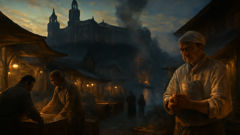
Krakow is a city of layered textures—clay tiles, carved stone, timber beams, and the ever-present river that measures time like a metronome. The Wawel Roost, where bishops and princes kept counsel, had its own traditions. People left coins at altars, lit candles, and told each other that the dragon was punishment or curse, a thing from older maps when forests were still full of monsters. Scholars argued about the creature’s origin—some declared it a test of faith, others a natural hazard given to exaggeration. But to the people who lived under its shadow, the question of why mattered little next to what to do. Stakes were practical: the river ferries, the fish markets, the law courts—life had to continue even with the cave beneath the hill breathing smoke.
Jakub the cobbler was not a man likely to be found in courtrooms or councils, but he was not invisible. His shop sat on a narrow lane that smelled of tanned hide and beeswax. He patched boots for the baker who kept his ovens warm, mended heels for the clerk who wrote by candlelight, sewed soles for the miller trudging mud between fields. His hands knew how to coax leather into form, how to read where a seam might give, how to make something whole again. Folk called him quiet, which was polite code for someone who listened. He watched the river’s patience and the city’s small economies—the way people moved, where the breadlines formed, how children hid from adult talk. When the dragon’s demands began—tribute of livestock or coin left at certain points along the terrace—Jakub noticed how the beast took only certain flesh and seemed to favor younger, softer animals. There was an appetite there, but also a pattern. Patterns are a cobbler’s friend. Jakub began to think in terms of fit and function: what the dragon chewed, how it swallowed, and what a creature that size might do when confronted by an unsuitable meal.
The city’s heralds promised rewards: gold, land, marriages arranged. Knights dreamt of glory. Priests called for prayer. But Jakub saw a different strategy. The knights attacked with lances and fury, aiming at the dragon’s bulk. Jakub, whose world had always been smaller and closer to ground, conceived a plan that approached the problem at the scale it required: not a clash of steel but an alteration of appetite. He spoke little of it, only measuring leather and making a crude model of shape and weight, testing seams by candle and thread by hand. Night after night while Krakow whispered and worried, he stitched and filled and experimented, using the knowledge of materials and the economy of the lane. Rumors of his intent traveled the way gossip does—softly, as if afraid a dragon might hear them—and some people mocked. A cobbler saving a city, they said, was the sort of fable told to frighten children into obedient sleep. Jakub worked regardless, and his quiet hours beneath lamplight became the first true counter to the dragon’s roar.
Alongside Jakub’s handiwork were other currents: fishermen arguing about the smell of the water, priests debating exorcism, and a woman who sold sheep in a crooked stall near the river. She watched Jakub’s visits and lent a bleating ewe now and then, the cost of compassion and curiosity braided together. The city waited, but not for long—time moves fastest where fear runs. Jakub’s plan needed the rhythm of the river and the timing of the beast. He patiently assembled his solution, not with sword or prayer but with leather, stuffing, and a knowledge of how appetite could be guided. In the end, what he offered the dragon would be not a challenge of blades but of beliefs: the idea that an artisan’s work could outmatch the brute force so often celebrated in epic banners. The stage was not a throne or a field but the river edge and the cave mouth, where city and hill meet, and where the ordinary might turn a quiet tradecraft into legend.
The Cobbler's Craft: A Plan Woven of Leather and Wit
Jakub’s plan was not born of hubris but of careful calculation. He studied the dragon’s traces and the habits of the animals it favored. He noticed that creatures taken from the riverside were often plump and young, and that the beast seemed to prefer warm, strong-smelling meat. Wary of direct attack, he resolved to alter what the dragon received. He would offer a meal that was fit to be eaten yet designed to make the beast reveal itself fully and, if luck—or craft—favored him, to change its course forever.
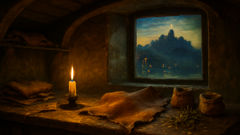
The cobbler’s shop became a place of conspiratorial industry. Jakub recruited a few allies: the sheep-seller with her patient hands, a cooper who owed him a favor and could supply a barrel, and an apothecary who, for a price or a pair of repaired shoes, lent him powders and bitter herbs. They worked in the hush between curfew and dawn, measuring and stitching. Jakub knew leather: he could make something that looked, at a glance, like what the dragon expected. He tanned hides to a sheen, sewed a shaggy pelt that would pass as warm wool, and stuffed it with a blend—herbs that would smell like a lamb’s marrow, fine charred bits to simulate blood, and a binding paste that would swell when damp. He took great care with weight and balance, because giants of appetite are suspicious of oddities; an awkwardly heavy offering might be deemed inedible. So Jakub crafted a creature to be eaten, both convincing and clever, the better to turn the dragon’s hunger into a trap.
Even a clever plan needs theater. Jakub and his allies set the stage along the Vistula where the current runs slow and the riverbank is shallow. They baited the trap late on a day when smoke was already curling from the cave mouth and the city huddled under quilts of worry. A boat was rowed to the shallows and the false lamb left near the bank, its pelt dampened to give off the right fragrance, its stuffing designed to do what makers do best: transform a material’s nature by intent. Sentries watched from alleys while children peered from windows with eyes wide as coins. The dragon, as if following the most reliable of instincts, rose from its cavern and slithered toward the offering. Jakub stood where he could see but not be seen, his face half-hidden under a coarse cap. He felt his pulse as if it were a stubborn thread he might pull too tight.
When the dragon approached, it tested the air—an animal’s sense reaching out like fingers to touch the world. The smell was right; the texture was right; the dragon took the bait without initial suspicion. It tore freely at the pelt and swallowed piece after piece. Inside, the stuffing began to react to the warmth and the damp, swelling in a way Jakub had engineered. The effect was not immediate; the dragon continued to eat, thickly and with relish, until a slow groan filled the valley. The beast was old and proud, and eating was a kind of ceremony, but the mimicked flesh inside the skin was changing it in ways the dragon did not foresee.
Some versions of this tale have the animal explode or the beast choke amid fireworks; Jakub’s approach was subtler. He designed the stuffing to trigger thirst like a desert wind. Herbs and salts that worked on digestion in smaller creatures were amplified; the dragon, in need of water, left its lair and bent toward the river in a desperation the city had never seen. It slurped and gulped until the Vistula churned, and then something unexpected happened. The creature’s great lungs, accustomed to drawing smoke from its cave, took in too much water at once, and the balance of fire and breath that had sustained its terror faltered. The dragon writhed as if trying to breathe both flame and river at once. Its roar was a sound that shook pigeons from ledges and made windows tremble, and then it rolled toward the bank with a stupor that looked almost like defeat.
Jakub did not run to stab the beast. He had not intended such violence, and his tools were needles and awls, not swords. What he sought was exposure—an end to the dragon’s secret advantage. As the creature lay gasping by the water, the cooper’s men pulled, and ropes were thrown. People came from houses, drawn by the noise, and saw not a tableaux of knights victorious but a humbled thing tangled by its own size and the cleverness of a craftsman. The sight broke Krakow’s decades of hardened fear into something softer: pity, wonder, and a renewed belief in possibility. The dragon, exhausted and sated in a way it could not reconcile, drew its last great rasping breath, then very slowly curled and sank into the shallow water. The river carried it a little downstream as if to claim a long-forgotten debt, and the city exhaled as if it had been holding its breath for a whole life.
What followed was practical: the men hauled, the women offered stern looks and a handful of knitting, and the children ran for coins and stories. Jakub stood aside, hands smelling faintly of oil and herb, and allowed the moment to be claimed by everyone. He did not clamor for reward. He accepted bread, a small parcel of coins, and the quiet gratitude of those whose lives had been unbolted from fear. Krakow adapted its story. In taverns voices rose and fell as storytellers embroidered and simplified, as tradition does. But the heart of the event remained—a craftsman’s solution had been the turning point, and it changed the way people thought about heroism. Strength still mattered on the borders of kingdom and commerce, but wit, patience, and the knowledge of trade became a kind of valor. Bells rang again, sales resumed, and the river—obdurate and forgiving as ever—took the memory of scales and steam and set it downstream. Jakub returned to his bench. He stitched soles for the miller, mended boots for the baker, and listened when mothers told him their children’s favorite version of the evening the dragon was ended. The city built small memorials: a carved stone near the river and later a statue that would breathe fire as a playful reminder that even the fiercest things can be softened by invention and community.
After the Breath: Legacy, Memory, and the Fire That Becomes Story
When the dragon’s breathing slowed to a hush, the city’s reaction was complicated and beautifully human. Some were jubilant, shouting and banging pots. Others were tentative, as if joy might scratch open the thin new skin of safety. Priests held masses of thanks, while elders told the young not to let arrogance swell among those who had sought glory with lances. The knights of Krakow, many of whom had ridden in defeat, found places in pageants and had their names sung in ballads that favored the hard-won color of armor; the cobbler’s name, meanwhile, traveled in quieter currents at first, stitched into domestic conversation. Folk remember what serves their needs: lenders prefer a hero who teaches method; children prefer one whose hands smell of bread and glue. Jakub remained modest. He mended shoes and watched the river. He accepted small rewards but refused pomp, perhaps because his life had always been smaller in scale but larger in intimacy.
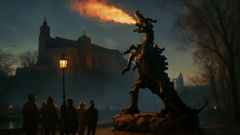
Stories, like embers, change shape depending on who holds them. In years to come, the city memorialized the event in multiple forms. A stone marker by the river told a terse version: “A dragon once terrorized this hill.” Tavern tales elaborated with dragons that breathed bluer fire or knights who forgot their names in the smoke. Minstrels played melancholic tunes about the beast’s loneliness and the cobbler’s gentle craft. And then, centuries later, a bronze figure of a dragon would stand near the hill, a modern piece that breathes fire in jest and offers visitors a playful echo of the old fear. The statue is a conversation between past and present: a city that remembers danger as well as the absurdity of its own panics. Tourists photograph the fire-breathing bronze and laugh; residents remember the hum that comes from living near a place layered with meaning.
Beyond monuments, the legend shaped everyday life. Craftsmen began to be viewed with a certain reverence, and the story of how an artisan resolved what armies could not passed from home to home. The moral was pragmatic: intelligence and practicality deserve a place next to bravery. Inns started naming dishes after the cobbler’s clever lamb; children prided themselves on learning a useful trade instead of imagining only banners and battlefields. Even the way Krakow planned its defenses changed slightly—governance took to heart that threats sometimes need thoughtful intervention rather than blunt force. The Vistula kept running, impartial and inevitable, its bed gathering all stories that fall into it. It held the remains of scales in its deeper bends, a secret archive that only fishermen and time might digest. The dragon’s ending was a proof to many that storms of crisis could be met with invention and cooperation.
Jakub’s life did not become a throne. He continued to live among people whose problems were often small and urgent: a child’s slipper separated at the seam, a traveler who could not afford new boots for the road. He fixed what needed fixing and listened when someone wanted to talk. The city, on the other hand, grew into a place that folded the legend into its identity. The hill that once housed a cavern of threat became a stage for festivals, cathedral processions, and the ordinary bustle of centuries. The dragon, in the end, was both creature and metaphor—a reminder that fear can be confronted by unanticipated minds and that a single person, skilled in the ordinary arts of repair and provision, can change a community’s fate.
There are quieter strands to this legacy, less often carved into stone but equally important. People learned to name tasks and pass them from hand to hand rather than insist on singular heroism. Crafts were taught with a different pride; elders told children that learning a trade could be as noble as learning to wield a sword. In that way, Krakow’s folklore reinforced the dignity of honest work. The Wawel Dragon became not just a tale of terror and relief but a story with human texture: the smell of tanned leather, the tick of a clockwork watch, the small generosity of lending a barrel or a patch of wool. When visitors arrive now, they find a city living in many centuries at once—streets where Gothic, Renaissance, and modern glass meet, a river that keeps the old current, and a statue of a dragon that breathes a theatrical fire on cool evenings. They are told how the cobbler solved what knights could not, and some smile, others are surprised, and many remember that sometimes it takes a quiet, steady hand to mend a wound that all the swords in the world could not touch.
When the story is told nowadays, each retelling uncovers different lessons. For children it is a tale of bravery made small and therefore attainable: if a shoemaker can save a city, then one can be brave too. For artisans it is a hymn to craft and observation. For leaders it is a reminder of humility—that clever answers often come from unexpected places. And for Krakow, the legend is part of its living atlas; the dragon beneath Wawel Hill is a presence not of terror anymore but of narrative gravity that pulls together history, identity, and the idea that communities survive by being clever, kind, and collaborative. The dragon sleeps now in story and stone, and Jakub’s work remains stitched into the city’s memory—an enduring seam between the ordinary and the legendary.
Conclusion
The story of the Wawel Dragon and the cobbler Jakub endures because it reframes what a hero might be. Where epics hunger for banners and single-handed triumphs, this legend celebrates the persistent work of hands that mend, the small economies of a city that hold people together, and the intelligence that sees how a problem might be re-shaped rather than only struck. Krakow’s valley still listens to the river, and the hill still keeps its secrets, but the tale has softened a fear into a teaching: ingenuity paired with community can turn a terror into a tale. Visitors who walk the terraces today see bronze and stone and hear a dragon’s remembered breath. They also see the bench of a cobbler in their imagination, a place where ordinary materials were turned into extraordinary outcomes. The Wawel Dragon lives now primarily as story and symbol, a reminder that danger is not immune to craft and that, sometimes, the most profound transformations begin with a person who knows how to stitch two pieces of leather together until they become whole again.

